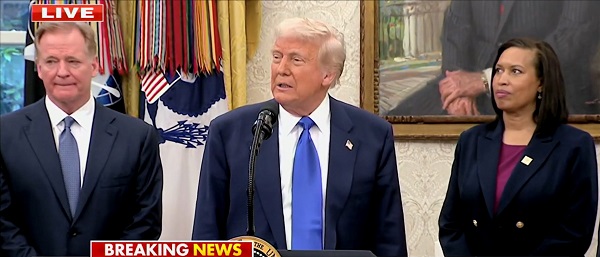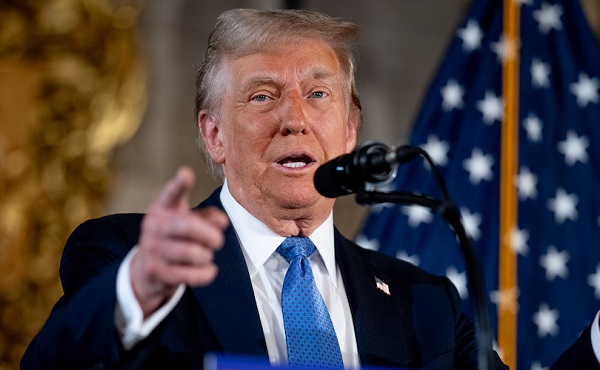Energy
Trump and Energy

From the Frontier Centre for Public Policy
By Terry Etam
Did you know that the United States Secret Service has a Chief of Communications? Does that not seem a little odd? To excel at his job, would he be perfectly silent?
Well, he’s not…Over the weekend the Chief of Communications of the United States Secret Service took to Twitter to start acting not very secret at all. How is this for a tweet: “…three charter flights filed with @SecretService agents, technicians, officers & mission support personnel safely arrived in Milwaukee.” He included a picture of one of the planes and all the debarked people standing on the tarmac.
I guess my definition of “Secret Service” is not that of the government’s, but then again, I’m not caught up in the same civil war-esque brouhaha over just what sort of curtain of madness would have descended over the world if Trump hadn’t turned his head that instant. Indeed, the past few days have been astonishing, watching players from across the spectrum and around the world reorient to accommodate what has happened.
Things are so complex, tense, and volatile that even the secret service feels the need to point out what it is doing, in great detail (though I’m sure the Director is muzzled re: the juicy stuff). In this environment predictions seem unwise, but hey that issue has never stopped me before, so here goes with a few observations of relevance to the energy industry.
As a building block of discussion, it is now highly probable that Trump will win the upcoming election. That ridiculously iconic photo of his bloody self with fist raised in front of the US flag is creating new Trump supporters out of not-insignificant online commentators that have spent years bashing him. Even Trump’s vice-presidential nominee, J.D. Vance, once expressed dislike for the big goofball (yes, he is: Exhibit A would be his tweet of a photo-shopped Trump tower in a Greenland village with the plea: “I promise not to do this to Greenland!” Of course he was many other things as well, but who could forget that…).
On the energy front, we know where Trump stands – drill baby drill. He wants to unleash American energy to drive down prices for consumers and increase competitiveness for US business. One aspect that goes unnoticed in this general discussion though is that there are material differences in what this means to the oil business/market versus the natural gas business/market.
He will focus on oil first. It will be symbolically important at a minimum for Trump to lower gasoline prices; they are a flashpoint because of the incessant visibility, the constant updating to a fraction of a cent in huge neon font as one drives down the road. Lowering gasoline prices will not be as easy as many think; for example, opening federal lands to drilling activity will not have any influence on gasoline prices for a long time, if at all. Trump could lower some forms of taxes in a bid to lower prices, but the effect of that would not be huge.
His main goal would be to expand oil production in a bid to lower prices, but this is where things get complicated in the modern age. The US is now a net exporter of oil, some 1.6 million b/d in 2023, a reversal of the situation of prior years. Now, the US still imports significant quantities of oil because its refineries require certain grades in greater quantities than it produces, and exports the grades it cannot utilize (mostly light oil).
This dynamic will make it tough for the US to drive down global prices on its own (oil is very much priced on the global stage), no matter what Trump does in the short term. A drilling frenzy, even if he could orchestrate one, would simply result in more oil exports until the quantity was large enough that it made a new global impact. But at that point, OPEC would be involved and pulling whatever strings it wanted to get the price where it wanted.
So, under Trump we should expect a flurry of feel-good vibes for the oil sector, with more friendly legislation, rules, and land leasing opportunities, but the impact on oil production will take time to achieve any price reductions. All other potential levers to reduce gasoline prices will be on the table, including existing federal regulations that are negatively impacting any downstream activity.
Natural gas is going to be more interesting. It is the unsung hero of industry; a vital cog that is critical to many industries and real estate ventures, but one that gets scant attention until something weird happens, like a shortage.
Natural gas shortages have historically been short term phenomena related to extreme weather events, and the price mechanism fixed the problem in a big hurry. Gas drillers are very good at what they do.
What has made natural gas so beneficial tot he US economy over the last decade is the fact that producers have reliably glutted the market, giving the US (and Canada) the lowest sustained natural gas prices on the planet. The economic benefit of that is hard to overestimate, since cheap natural gas enables so many beneficial industrial processes and keeps power and heating bills reasonable for consumers.
But if all that LNG export capacity is built, and if all the proposed AI data centres are built as planned, there will be significant strain on North American producers to meet that surge in demand. New LNG capacity and expected data center demand could, by 2030, add 20-30 bcf/d of new demand, in a 100 bcf/d market. Adding those volumes will be an enormous challenge and will require higher prices to incentivize producers to make it happen.
But higher prices will be exactly what Trump does not want. So, one can safely assume he will be pushing hard on US producers to expand output and will make it much easier to build infrastructure. That will help, but it is going to be a tough balancing act to ensure production increases sufficiently while at the same time keeping the cost of the vital fuel low. Natural gas markets would most certainly benefit from the relative stability of oil prices, however that is much harder to do in a “just in time” market which natural gas essentially is.
And then on top of it all, despite the importance of energy prices and availability, all will be background noise compared to the circus that will accompany his second run at presidency. The world is becoming more bifurcated and the US’ position in it is changing. There are enough active wars to make any human sick, and the US has to balance where to be involved and where not, which is as far from simple as can be. Additionally, the world is tectonically drifting into the wealthy west, the golden billion, and the ‘rest of the world’, the 7 billion that aspire to live like the west does.
On top of that, the people that hate Trump really, really hate Trump. One reason the west is in such turmoil is because of the polarizing nature of not just Trump, but of the reaction to Trump.
We will see though – at time of writing, Trump, in a post-shooting interview, said that he had ripped up his planned speech for the Republican National Convention. It was going to be a “humdinger” (his word, or course) attacking Biden’s record. However, his latest version will focus on unifying the nation. Let’s hope it works, rooting for you my American friends. No one will be better off if the US does not regain its footing.
Terry Etam is a columnist with the BOE Report, a leading energy industry newsletter based in Calgary. He is the author of The End of Fossil Fuel Insanity. You can watch his Policy on the Frontier session from May 5, 2022 here.
Automotive
Federal government should swiftly axe foolish EV mandate

From the Fraser Institute
Two recent events exemplify the fundamental irrationality that is Canada’s electric vehicle (EV) policy.
First, the Carney government re-committed to Justin Trudeau’s EV transition mandate that by 2035 all (that’s 100 per cent) of new car sales in Canada consist of “zero emission vehicles” including battery EVs, plug-in hybrid EVs and fuel-cell powered vehicles (which are virtually non-existent in today’s market). This policy has been a foolish idea since inception. The mass of car-buyers in Canada showed little desire to buy them in 2022, when the government announced the plan, and they still don’t want them.
Second, President Trump’s “Big Beautiful” budget bill has slashed taxpayer subsidies for buying new and used EVs, ended federal support for EV charging stations, and limited the ability of states to use fuel standards to force EVs onto the sales lot. Of course, Canada should not craft policy to simply match U.S. policy, but in light of policy changes south of the border Canadian policymakers would be wise to give their own EV policies a rethink.
And in this case, a rethink—that is, scrapping Ottawa’s mandate—would only benefit most Canadians. Indeed, most Canadians disapprove of the mandate; most do not want to buy EVs; most can’t afford to buy EVs (which are more expensive than traditional internal combustion vehicles and more expensive to insure and repair); and if they do manage to swing the cost of an EV, most will likely find it difficult to find public charging stations.
Also, consider this. Globally, the mining sector likely lacks the ability to keep up with the supply of metals needed to produce EVs and satisfy government mandates like we have in Canada, potentially further driving up production costs and ultimately sticker prices.
Finally, if you’re worried about losing the climate and environmental benefits of an EV transition, you should, well, not worry that much. The benefits of vehicle electrification for climate/environmental risk reduction have been oversold. In some circumstances EVs can help reduce GHG emissions—in others, they can make them worse. It depends on the fuel used to generate electricity used to charge them. And EVs have environmental negatives of their own—their fancy tires cause a lot of fine particulate pollution, one of the more harmful types of air pollution that can affect our health. And when they burst into flames (which they do with disturbing regularity) they spew toxic metals and plastics into the air with abandon.
So, to sum up in point form. Prime Minister Carney’s government has re-upped its commitment to the Trudeau-era 2035 EV mandate even while Canadians have shown for years that most don’t want to buy them. EVs don’t provide meaningful environmental benefits. They represent the worst of public policy (picking winning or losing technologies in mass markets). They are unjust (tax-robbing people who can’t afford them to subsidize those who can). And taxpayer-funded “investments” in EVs and EV-battery technology will likely be wasted in light of the diminishing U.S. market for Canadian EV tech.
If ever there was a policy so justifiably axed on its failed merits, it’s Ottawa’s EV mandate. Hopefully, the pragmatists we’ve heard much about since Carney’s election victory will acknowledge EV reality.
Daily Caller
Trump Issues Order To End Green Energy Gravy Train, Cites National Security


From the Daily Caller News Foundation
By Audrey Streb
President Donald Trump issued an executive order calling for the end of green energy subsidies by strengthening provisions in the One Big Beautiful Bill Act on Monday night, citing national security concerns and unnecessary costs to taxpayers.
The order argues that a heavy reliance on green energy subsidies compromise the reliability of the power grid and undermines energy independence. Trump called for the U.S. to “rapidly eliminate” federal green energy subsidies and to “build upon and strengthen” the repeal of wind and solar tax credits remaining in the reconciliation law in the order, directing the Treasury Department to enforce the phase-out of tax credits.
“For too long, the Federal Government has forced American taxpayers to subsidize expensive and unreliable energy sources like wind and solar,” the order states. “Reliance on so-called ‘green’ subsidies threatens national security by making the United States dependent on supply chains controlled by foreign adversaries.”
Dear Readers:
As a nonprofit, we are dependent on the generosity of our readers.
Please consider making a small donation of any amount here.
Thank you!
Former President Joe Biden established massive green energy subsidies under his signature 2022 Inflation Reduction Act (IRA), which did not receive a single Republican vote.
The reconciliation package did not immediately terminate Biden-era federal subsidies for green energy technology, phasing them out over time instead, though some policy experts argued that drawn-out timelines could lead to an indefinite continuation of subsidies. Trump’s executive order alludes to potential loopholes in the bill, calling for a review by Secretary of the Treasury Scott Bessent to ensure that green energy projects that have a “beginning of construction” tax credit deadline are not “circumvented.”
Additionally, the executive order directs the U.S. to end taxpayer support for green energy supply chains that are controlled by foreign adversaries, alluding to China’s supply chain dominance for solar and wind. Trump also specifically highlighted costs to taxpayers, market distortions and environmental impacts of subsidized green energy development in explaining the policy.
Ahead of the reconciliation bill becoming law, Trump told Republicans that “we’ve got all the cards, and we are going to use them.” Several House Republicans noted that the president said he would use executive authority to enhance the bill and strictly enforce phase-outs, which helped persuade some conservatives to back the bill.
-

 International2 days ago
International2 days agoSecret Service suspends six agents nearly a year after Trump assassination attempt
-

 Bruce Dowbiggin2 days ago
Bruce Dowbiggin2 days agoThe Covid 19 Disaster: When Do We Get The Apologies?
-

 Crime1 day ago
Crime1 day agoSweeping Boston Indictment Points to Vast Chinese Narco-Smuggling and Illegal Alien Labor Plot via Mexican Border
-

 Alberta1 day ago
Alberta1 day agoAlberta school boards required to meet new standards for school library materials with regard to sexual content
-

 Business14 hours ago
Business14 hours agoTrump slaps Brazil with tariffs over social media censorship
-

 Environment1 day ago
Environment1 day agoEPA releases report on chemtrails, climate manipulation
-

 Business2 days ago
Business2 days ago‘Experts’ Warned Free Markets Would Ruin Argentina — Looks Like They Were Dead Wrong
-

 International14 hours ago
International14 hours agoSupport for the Ukraine war continues because no one elected is actually in charge.




